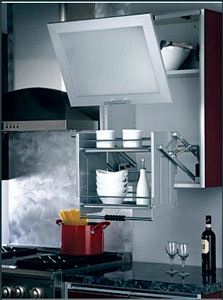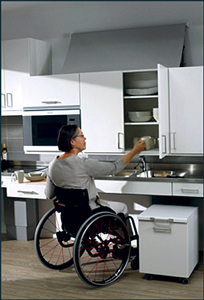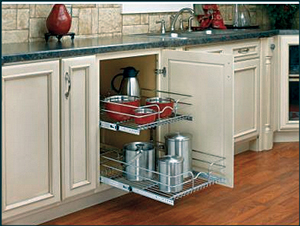
For more than 20 years, the American Institute of Architects’ Design for Aging Review has tracked the evolution and refinement of the “household model” for senior living facilities, and now, housing design for seniors is undergoing an industry shift.
Conceptually, the household model is meant to change the institutional culture of long-term care facilities to a more home-like setting. The typical household model facility includes 10 to 16 private rooms, each with an efficiency kitchen that’s equipped with a microwave or hot plate, and a full bathroom. In a common area, there’s a fully equipped residential-style kitchen—often called a “country kitchen”— and a small dining area for the use of members of that household. Most household plans also include a “living room” that is shared by household members and their guests. An example of the kitchen and dining area at Royal Oaks, a Lifecare community in Arizona, can be seen below.

When the biennial “Design for Aging Review” was first published in 1992, the household model was most often applied in dementia/memory support facilities, but in the most recent review (2014), more than two-thirds of the projects that received recognition—including skilled nursing and assisted living facilities — incorporated household model features. It is also interesting that many of the award winners were remodeling projects rather than new construction. It’s in the makeovers of dining facilities that we see innovations in country kitchen designs.
Growing popularity of country kitchen remodels
The trend in long-term care communities across the country, according to Lakeside Food Service (a supplier of foods and equipment to institutions throughout the Midwest), is to replace cafeteria-like dining rooms with country kitchens. Smaller dining areas and family-style kitchens are intended to help residents feel more at home.
In household model facilities, staff and residents are more integrated. The smaller kitchen/dining areas encourage residents and staff to cook alongside one another. Country kitchens help residents to be more involved in their own care and encourage them to socialize and feel as if they’re part of a family.
“Mealtime is a time when people have the greatest opportunity to do something that is familiar, comfortable and non-invasive,” says Anna Ortigara, a registered nurse and board president of the Pioneer Network, which advocates for person-directed care and culture change in eldercare. “We need to make sure we are setting up situations in which residents can do as much as possible for themselves, and we need to pay attention to steps they can take to be successful.”
One integral step for kitchen designers to take is to ensure accessibility to counters, sinks, cooktops and items stored in cabinets, to all residents who wish to use them. That means lowering counter and wall-cabinet heights, and providing knee spaces beneath them to accommodate users in wheelchairs. It also means minimizing the need for reaching, bending and stooping for access to cookware, tableware and pantry supplies. See examples of these accessible amenities below:



The new country kitchens in updated care facilities do more than foster a family environment and facilitate socializing. When cooking for oneself is encouraged — even at a limited level — occupants of care facilities experience social, physical and cognitive stimulation. Not only does work in the kitchen (like chopping vegetables and lifting pots and pans) stimulate hand, arm and neck muscles, it requires sensory awareness and activates parts of the mind that may not otherwise get frequent use in a care facility environment.
Perhaps most importantly, cooking provides both purpose and a means for social interaction. The communal country kitchen environment — like the modern trend toward open, sociable kitchen design in homes — encourages occupants to spend time there and actively participate in meal preparation.
To be sure, not all long-term care residents want to cook for themselves or with others at every meal. For that reason, in many long-term care facilities today, country kitchens are situated adjacent to “cafes” and “grab-and-go” food stands offering prepared soups, sandwiches and coffee with intimate seating nearby. In such blended dining environments, those who want to cook for themselves can still interact over food with those who don’t.
The takeaway from all of this, according to the AIA report “Insights and Innovations: The State of Senior Housing,” is that many organizations dedicated to serving seniors, “. . . have developed entire philosophies and businesses around the [household model] concept. Others are taking incremental but strategic steps to incorporate culture change in their communities.” The evolving country kitchen is, indeed, an important part of the changing culture in long-term care.
Michael Chotiner is a home improvement expert and homeowner who writes for The Home Depot. His experience as a contractor and cabinetmaker gives him great insight on designing kitchens for many different types of living situations, which he shares for The Home Depot. You can check out all the different kitchen and cabinet options for seniors and others at The Home Depot.





